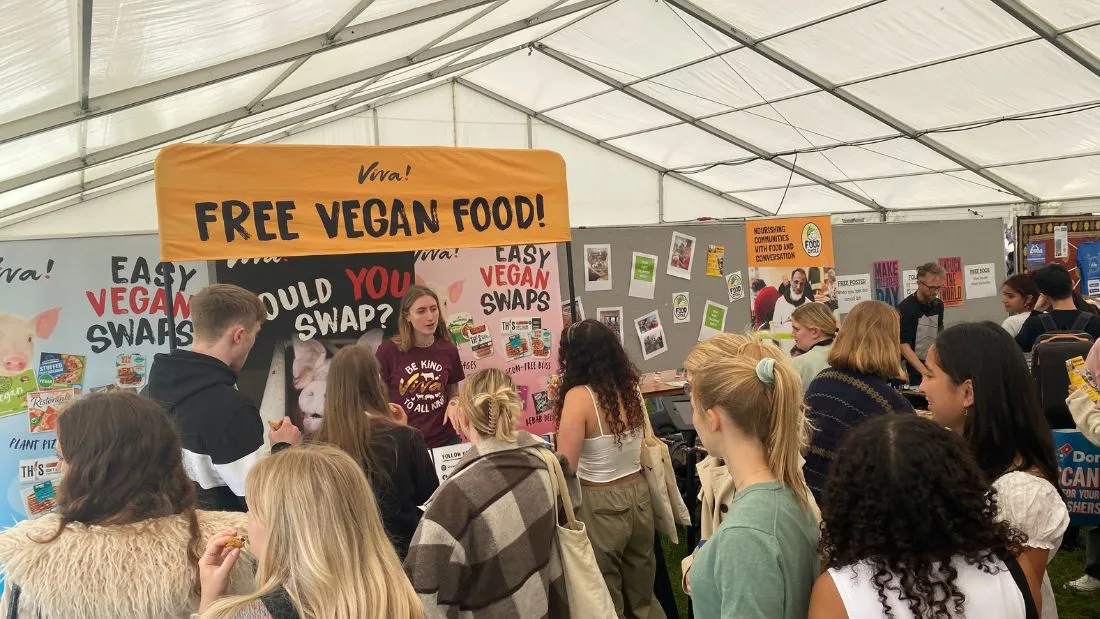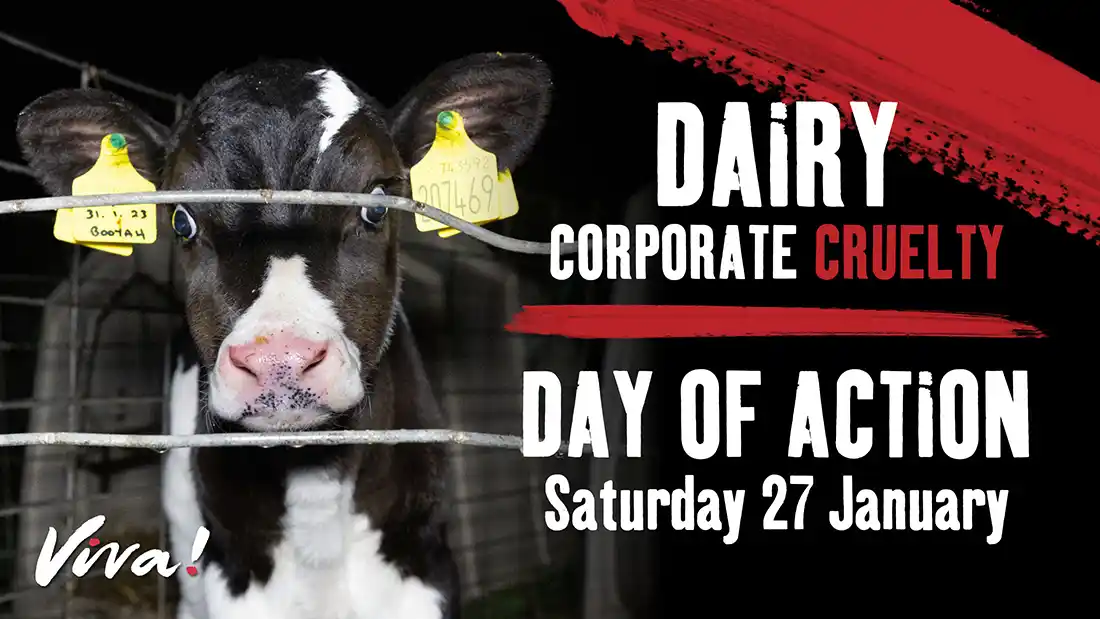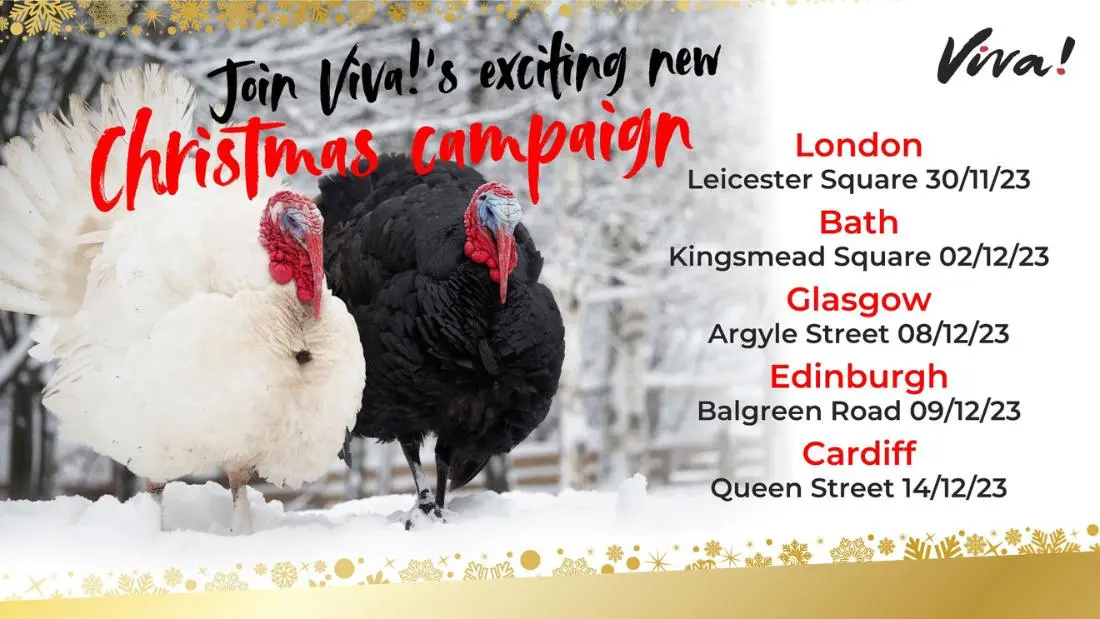How Goats Are Farmed and Killed


- Goats have different accents, along with elephants, dolphins and humans.6The Telegraph, 2012. ‘Goats “can develop their own accents.”’ The Telegraph, 16 February. Available at https://www.telegraph.co.uk/news/science/science-news/9085654/Goats-can-develop-their-own-accents.html [Accessed 16 April 2020].
- Goats are excellent climbers and can even climb to the top of trees!7Bednarz, C., 2017. ‘Watch These Bizarre Tree-Climbing Goats in Action.’ National Geographic, 10 May. Available at https://www.nationalgeographic.com/travel/destinations/africa/morocco/video-watch-bizarre-tree-climbing-goats-in-action-morocco/ [Accessed 16 April 2020].
- Legend has it that goats discovered coffee’s excitable effects after people noticed them dancing whenever they ate coffee berries.8National Coffee Association. ‘The History of Coffee.’ National Coffee Association USA. Available at https://www.ncausa.org/About-Coffee/History-of-Coffee [Accessed 16 April 2020].
- Goats can communicate with humans in much the same way as dogs and cats do, and form strong bonds with humans when given the opportunity.9Nawroth, C., Brett, J., McElligott, A., 2016. ‘Goats Display Audience-Dependent Human-Directed Gazing Behaviour In A Problem-Solving Task.’ Biology Letters, 1 July. Available at https://royalsocietypublishing.org/doi/full/10.1098/rsbl.2016.0283 [Accessed 16 April 2020].
- Goats are highly intelligent and curious and have a constant desire to explore – quickly investigating things that are unfamiliar.
- Goats sneeze as an alarm! This warns other goats of danger.
- Goats (along with sheep, octopuses and toads) have rectangular shaped pupils.10Cox, A., 2008. The Evolution of the Rectangular Eye. Science 20, 21 October. Available at https://www.science20.com/variety_tap/evolution_rectangular_eye [Accessed 7 May 2020]. This gives better perception of depth in their peripheral vision – important for goats who spend their time evading predators in a rugged terrain.
We may not associate goats with endurance, incredible agility and toughness but they are quite remarkable animals. Look beyond their peculiar eyes, floppy ears and playful nature and you’ll find that goats have extraordinary climbing skills, enabling them to shoot up dams1BBC, 2016. ‘The incredible ibex defies gravity and climbs a dam.’ BBC, 12 July. Available at https://www.youtube.com/watch?v=RG9TMn1FJzc [Accessed 24 April 2020]. at just a few days old, and have adapted to live in some of the most extreme environments around the world.
Goats are not only excellent climbers but different breeds have evolved to survive a wide range of climates. They are found in a range of terrains, from the Rocky Mountains of North America to the very high montane forests of Turkey and East Africa. The Mountain Goats of North America are perhaps the most famous of wild goats, roaming high-altitude habitats, withstanding temperatures of -46 degrees C and winds that reach almost 100mph. With strong necks and shoulders, as well as their specialised hoofs, mountain goats can climb up 450 metres vertically in less than 20 minutes2JustFunFacts, 2018. ‘Interesting facts about mountain goats.’ JustFunFacts. Available at http://justfunfacts.com/interesting-facts-about-mountain-goats/ [Accessed 24 April 2020]. – that’s about five times the height of Big Ben!
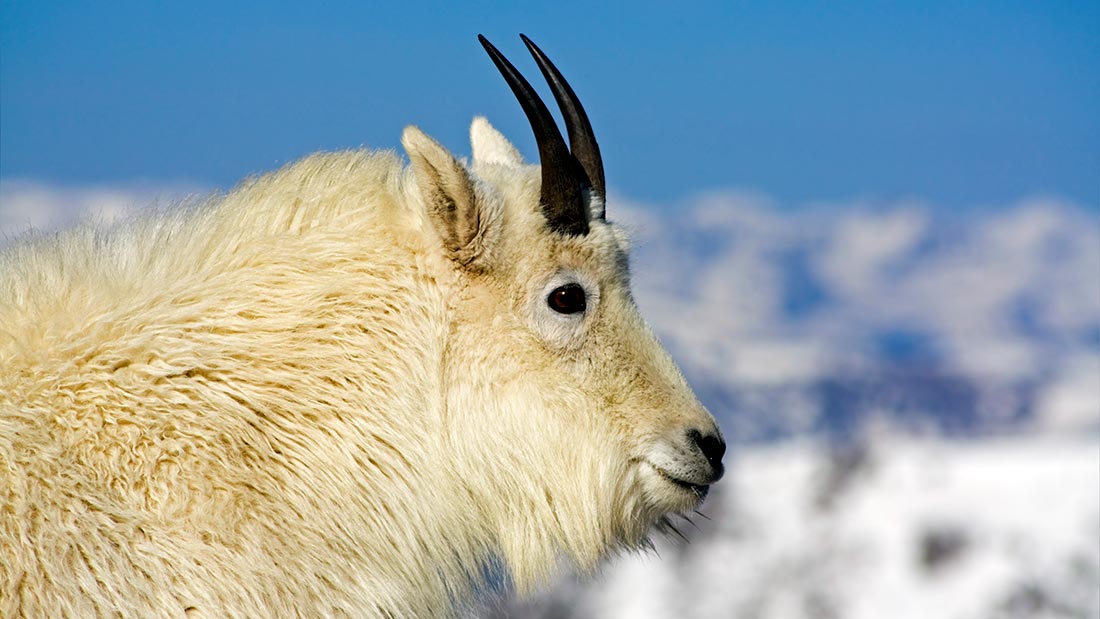
While Mountain Goats have evolved to survive incredibly tough alpine conditions, the Bezoar Ibex – one of the main ancestors for domesticated goats – boasts the longest horns of any animal in relation to their body weight, and which can reach up to 1.5 metres in length.13Clutton-Brock, J., 1999. ‘A Natural History Of Domesticated Mammals.’ 2nd ed. London: Cambridge University Press. Unlike mountain goats who have evolved to survive below freezing temperatures, Ibex have shiny coats that keep them cool even in desert conditions.14Bradford, A., 2014. ‘Facts About Ibex.’ LiveScience, 23 July. Available at https://www.livescience.com/28102-ibex.html [Accessed 24 April 2020]. Despite the heat, they can jump more than six feet in the air and effortlessly climb mountains, all the while carrying impressive horns which are used in part to decide social structures in the mating season.
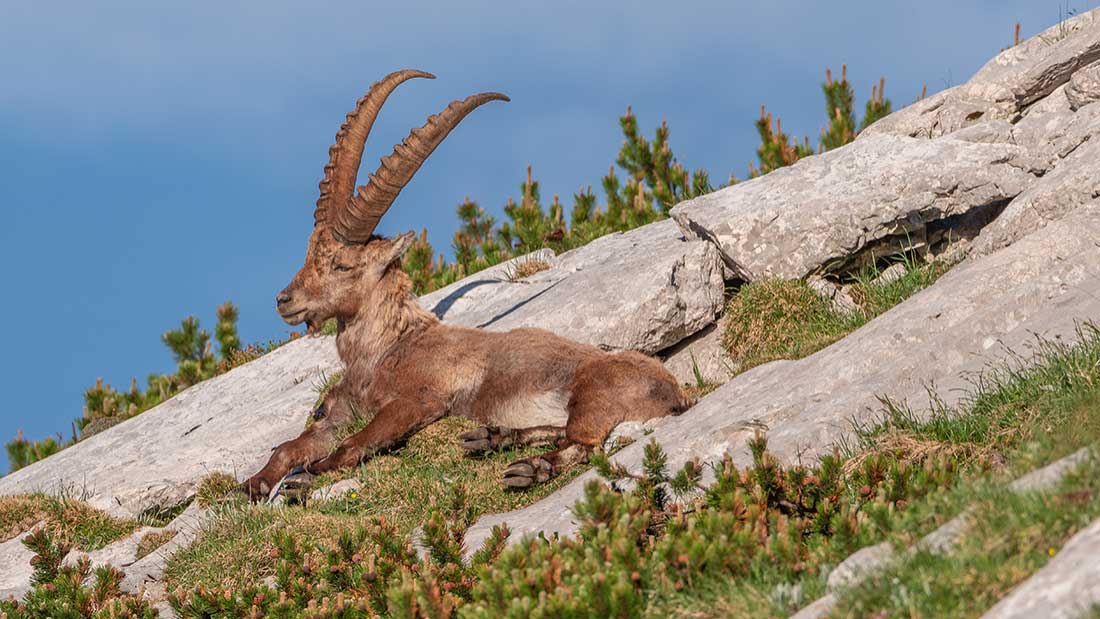
While goats of many breeds survive in incredibly tough, gruelling conditions, they maintain a playful, curious nature, as witnessed in the viral video of wild goats taking over Llandudno, a Welsh town, during the 2020 lockdown5The Guardian, 2020. ‘Goats take over empty Welsh streets as residents observe coronavirus lockdown.’ The Guardian, 31 March. Available at https://www.youtube.com/watch?v=xcDvM3PdVsc [Accessed 24 April 2020].; or the craze that is goat yoga (goats doing yoga with people). A 2018 study6BBC, 2018. ‘Goats prefer people with happy faces.’ BBC, 29 August. Available at https://www.bbc.co.uk/newsround/45343152?intlink_from_url=https://www.bbc.co.uk/news/topics/cly49x4jp6mt/goats&link_location=live-reporting-story [Accessed 24 April 2020]. revealed that goats prefer to hang around people with happy faces rather than those with angry expressions and that they have extraordinary communication skills with humans. Just like so many farmed animals who have been stereotyped unfairly, goats have been given a bad rap as greedy animals who will eat just anything. There is clearly more to them than meets the eye.
Where Do Goats Descend From?
Today’s wild goats give us a good idea of what domesticated goats’ natural lives would be like if they weren’t farmed – in the UK, primarily for their milk and, to a lesser degree, their flesh.
Domesticated goats are a subspecies of the wild goats of southwest Asia and eastern Europe and are a member of the Bovidae family.1Bradford, A., 2015. ‘Facts About Goats.’ Live Science. Available at https://www.livescience.com/52540-goat-facts.html [Accessed 21 April 2020]. There are just under a billion goats across the world today with over 200 distinct breeds. They were one of the first animals to be domesticated and used by humans, at least 10,000 years ago.2Smithsonian’s National Zoo & Conservation Biology Institute. ‘Goat.’ Smithsonian’s National Zoo & Conservation Biology Institute. Available at https://nationalzoo.si.edu/animals/goat [Accessed 17 April 2020].
Wild Goats
Wild goats still live around the world, mostly in southwestern Asia, and if we ceased to use goats for meat and dairy there would still be a diverse number across multiple continents. Their mountainous terrain is very different to the confined conditions in which they’re kept in modern farming. They are small ruminants, like sheep, though much more agile than their woolly cousins.
Goats are naturally independent and curious animals, with a complex, matriarchal social structure in the wild of about 20 animals.2Smithsonian’s National Zoo & Conservation Biology Institute. ‘Goat.’ Smithsonian’s National Zoo & Conservation Biology Institute. Available at https://nationalzoo.si.edu/animals/goat [Accessed 17 April 2020]. Strength, size and age are important factors in deciding a leader and social status tends to be handed down through the generations.
Natural Diet
Contrary to popular belief, goats won’t eat just anything.3Bednarz, C., 2017. ‘Watch These Bizarre Tree-Climbing Goats in Action.’ National Geographic, 10 May. Available at https://www.nationalgeographic.com/travel/destinations/africa/morocco/video-watch-bizarre-tree-climbing-goats-in-action-morocco/ [Accessed 16 April 2020]. They are browsers, meaning that they will explore and eat a diverse range of vegetation such as roots and shrubs and will even climb trees to reach particularly tasty leaves.
Life Expectancy of Goats
A goat’s life expectancy ranges from approximately eight to 20 years, depending on the breed.4World Life Expectancy. ‘Domestic Goat.’ World Life Expectancy. Available at https://www.worldlifeexpectancy.com/mammal-life-expectancy-domestic-goat [Accessed 17 April 2020].
Predators
There are a variety of natural predators for goats, ranging from foxes and eagles, who prey on kids, to coyotes, wolves and mountain lions.5Moore, V., 2019. ‘8 Common Goat Predators – And What You Can Do About Them.’ PredatorGuard, March 29. Available at https://www.predatorguard.com/blog/goat-predators [Accessed 17 April 2020].
Wild Goats and Domesticated Goats
Much of the behaviour found in wild goats is still found in domesticated goats. Despite nanny goats’ close bonds with their kids, and their curious, exploratory nature, the life they endure in modern farming is a far cry from both their natural environments and way of living.
Summary
Goats’ cheese and milk are becoming increasingly popular amongst consumers,1Knowlson, L., 2017. ‘Growing Share in Goat Milk’s UK Market.’ York Press, 20 September. Available at https://www.yorkpress.co.uk/business/news/15527919.growing-share-in-goat-milks-uk-market/ [Accessed 21 April 2020]. with many mistakenly presuming that the welfare problems inherent in milking dairy cows don’t apply to goats. The truth is a disturbingly similar picture of death, mutilation and disease that’s seen in dairy farming.
Size of the Goat Industry
Around 108,000 goats are farmed in the UK.2Rivera, L., 2019. ‘We Need To Be Eating Kid Meat, But What’s The Right Way For It To Be Farmed?’ The Independent, 4 October. Available at https://www.independent.co.uk/life-style/food-and-drink/eating-goat-meat-goatober-kid-farming-industry-dairy-a9128591.html [Accessed 21 April 2020]. In 2017, over 16 million litres of goat’s milk were sold to UK consumers.1Knowlson, L., 2017. ‘Growing Share in Goat Milk’s UK Market.’ York Press, 20 September. Available at https://www.yorkpress.co.uk/business/news/15527919.growing-share-in-goat-milks-uk-market/ [Accessed 21 April 2020]. The industry is predicted to continue to grow as consumers switch from cows’ milk in their search for more ethical or healthier milks, encouraged by misleading marketing claims from the goat industry. Delamere is one of the most recognisable companies in the UK selling goats’ milk, cheese, yoghurt and butter and who encourage and profit from misleading imagery about goat farming.
Breeding
Like dairy cows, goats need to be made pregnant in order to produce milk. Impregnation usually happens around the age of 18 months through the use of a ‘stud’ billy from a line of high milking-producing animals. They have a five month pregnancy and often produce twins or even triplets as a result of selective breeding.
Some nanny goats are impregnated through artificial insemination (AI) rather than through natural mating.3James, D., 2020. ‘How A Goat Farmer Has Lifted AI Conception Rates.’ Farmers Weekly, 6 April. Available at https://www.fwi.co.uk/livestock/livestock-breeding/how-a-goat-farmer-has-lifted-ai-conception-rates [Accessed 24 April 2020]. The process of AI is painful and traumatic for goats, who are forced to stand only on their front legs and restrained while the farmer inserts an AI gun into their vagina to deposit sperm. This unnatural impregnation causes distress, particularly when mishandling of the goats’ organs leads to nerve damage and severe pain. Inexperienced farmers practise on live animals and this inevitably leads to injuries.
To produce a milk yield which satisfies the farmer, goats are kept in a perpetual cycle of impregnation, being separated from their kid shortly after birth, and lactation, in a similar way to dairy farming.
Kids

Goats are well-known for their mothering abilities, often fostering orphaned or rejected lambs, calves and even foals.4Elder, L., 2018. ‘Nanny Goat “Adopts” Orphaned Foal After Tragic Loss of Mare.’ Horse and Hound, 10 October. Available at https://www.horseandhound.co.uk/news/nanny-goat-adopts-foal-iggy-pop-sheshe-667371 [Accessed 21 April 2020]. Despite this, on most dairy farms the maternal needs of both nannies and kids are almost immediately curtailed after birth.
Mothers and kids are separated a few days after giving birth so that the mother’s milk can be taken for human consumption. Goats remember the distinct call of their babies even after a year of separation, suggesting strong bonds are formed between mother and kid at an extremely early age.5Briefer, E., Padilla de la Torre, M., McElligott, A., 2012. ‘Mother Goats Do Not Forget Their Kids’ Calls.’ Proceedings of The Royal Society, 20 June. Available at https://royalsocietypublishing.org/doi/pdf/10.1098/rspb.2012.0986 [Accessed 21 April 2020]. To be separated after a few hours or a few days is a painful process for both the kid and mother.
Unwanted billy goats – who can’t produce milk and are therefore seen as worthless to goat dairying – are killed in a number of ways.2Rivera, L., 2019. ‘We Need To Be Eating Kid Meat, But What’s The Right Way For It To Be Farmed?’ The Independent, 4 October. Available at https://www.independent.co.uk/life-style/food-and-drink/eating-goat-meat-goatober-kid-farming-industry-dairy-a9128591.html [Accessed 21 April 2020]. The only legislation in Britain is that there should be no ‘avoidable pain’.6Humane Slaughter Association, 2018. ‘Humane Dispatch and Disposal of Kids and Lambs.’ Humane Slaughter Association, April. Available at https://www.hsa.org.uk/downloads/technical-notes/tn7-despatch-and-disposal-of-kids-and-lambs.pdf [Accessed 21 April 2020]. Some kids are killed with firearms, such as rifles or even shotguns.7Department for Environment, Food And Rural Affairs, 2015. ‘Red Meat Slaughterhouses: Restraining, Stunning, Killing Animals.’ Defra, 15 October. Available at https://www.gov.uk/guidance/red-meat-slaughterhouses-restraining-stunning-killing-animals#animal-stunning-and-killing [Accessed 9 April 2020]. A penetrative captive bolt fired into the head to produce a ‘percussive blow’ is explicitly allowed. It is intended to make the kid lose consciousness with the first shot but it may or may not work and have to be fired again. The baby animal then has his throat cut.8Farm Animal Welfare Committee, 2017. ‘Opinion on the Welfare of Animals Killed On-Farm.’ FAWC, September. Available at https://assets.publishing.service.gov.uk/government/uploads/system/uploads/attachment_data/file/695225/fawc-opinion-welfare-of-animals-killed-on-farm-march2018.pdf [Accessed 21 April 2020]. It is estimated that 70-90,000 kids are killed on farms every year.9Hayward, T., 2018. ‘The Kids Are Alright: A Goat Meat Revolution.’ Financial Times, 12 January. Available at https://www.ft.com/content/4b4f3692-f595-11e7-88f7-5465a6ce1a00 [Accessed 21 April 2020].

Mutilations
Male kids that are kept to be fattened for the meat trade will be castrated, typically within one week of birth.10Mowlem, A., 2011. ‘Goats’ in ‘Management and Welfare of Farmed Animals.’ The UFAW Farm Handbook. Chichester: Wiley-Blackwell. 379. The UK government’s Farm Animal Welfare Council (FAWC) describes castration for lambs as causing ‘pain and distress’ and urges it to be used as little as possible.11Farm Animal Welfare Council, 2008. ‘FAWC Report On The Implications Of Castration And Tail Docking For The Welfare Of Lambs.’ Farm Animal Welfare Council, June. Available at https://assets.publishing.service.gov.uk/government/uploads/system/uploads/attachment_data/file/325125/FAWC_report_on_the_implications_of_castration_and_tail_docking_for_the_welfare_of_lambs.pdf [Accessed 26 April 2020]. Similar methods are used for goats but because goat farming remains small and relatively new to the UK, there is less research on the effect of kids and castration – but a similar mutilation would undoubtedly cause a similar level of pain as that inflicted on lambs. At the very least, FAWC urges that pain relief is used but this is not a legal requirement. Because anaesthesia would cost the farmer, it is probable that most kids are castrated while fully conscious, feeling everything that is done to them. This is exactly what Viva! filmed on a leading UK goat farm.
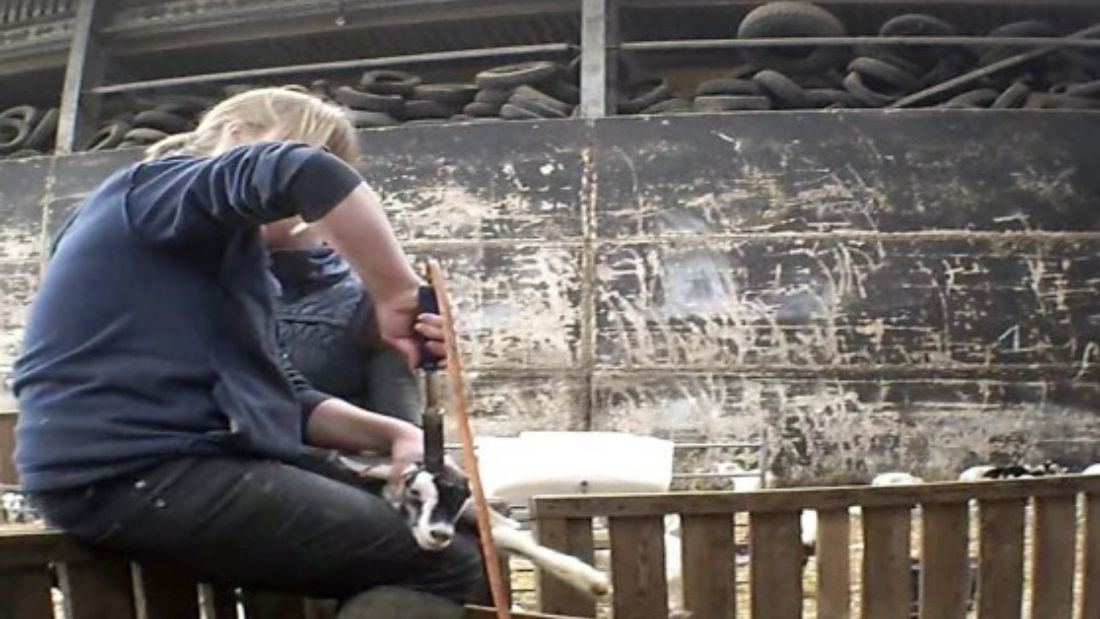
Kids are born with vestigial horn buds and in the dairy industry, they are disbudded within the first seven days of birth.12British Veterinary Association, 2018. ‘BVA and Goat Veterinary Society policy position on goat kid disbudding and analgesia.’ BVA, August. Available at https://www.bva.co.uk/media/2749/goat-disbudding.pdf [Accessed 21 April 2020]. The British Veterinary Association acknowledges that disbudding can cause ‘stress, acute pain […] and the possibility of chronic pain’, such that the mutilation can cause ‘changes in behaviour’ through the ‘pain and distress’ caused. Again, Viva! has filmed the shocking procedure of disbudding.
De-horning mature goats is ‘a difficult and unpleasant procedure that is very traumatic for the goat and should only be carried out as a last resort’.10Mowlem, A., 2011. ‘Goats’ in ‘Management and Welfare of Farmed Animals.’ The UFAW Farm Handbook. Chichester: Wiley-Blackwell. 379.
Life Cycle
Female kids are typically removed from their mothers after one feed and subsequently fed milk replacer so that the mother’s milk can be used solely for human consumption.13Tractor Supply Co, 2019. ‘How to Raise a Healthy Baby Goat Kid.’ Tractor Supply Co, July 29. Available at https://www.tractorsupply.com/tsc/cms/life-out-here/the-barn/animal-medication-for-goats/how-to-raise-a-healthy-baby-goat [Accessed 24 April 2020]. Sometimes the kid and mother will not even have that interaction as many young are fed immediately by bottle to manage their colostrum intake.
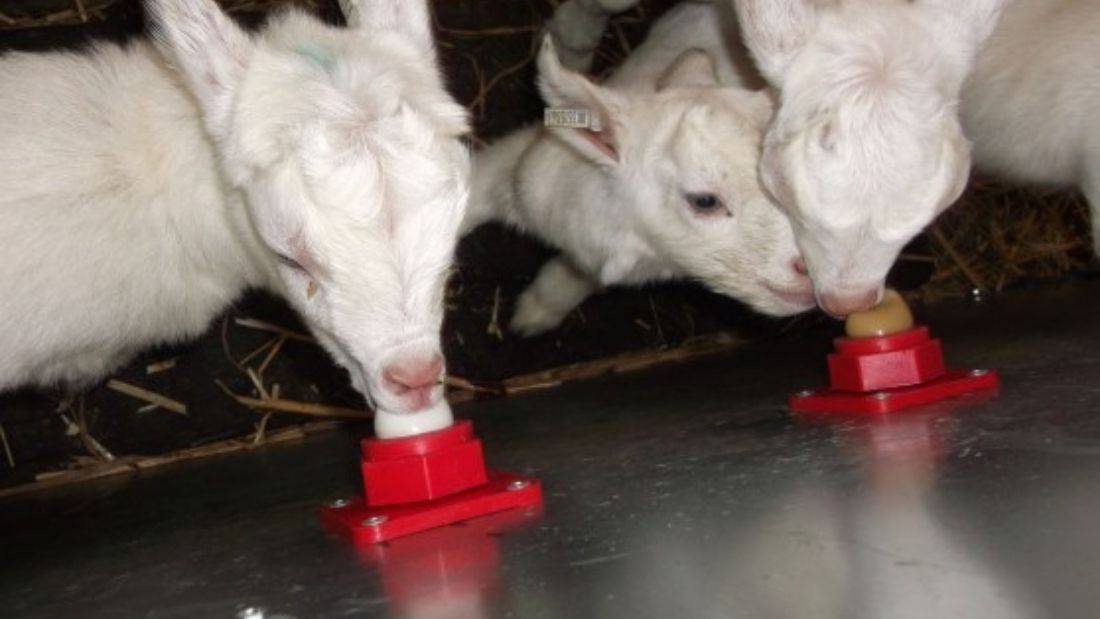
When the mother goat’s milk yield starts to dry up, she will be made pregnant again and the whole process is repeated again.
After a number of cycles, when her milk yield starts to permanently drop, she will be slaughtered, her place being taken by a young female. Depending on whether the kid is a ‘pedigree’ breed or not, the British Goat Society (BGS) recommends impregnation between six and 18 months of age.14British Goat Society (BGSa). ‘Breeding.’ British Goat Society. Available at https://www.britishgoatsociety.com/about-us/breeding/ [Accessed 24 April 2020].
Milk Yield
Following birth, lactation in a non-pregnant goat can be maintained for up to two years, but as this protracted lactation results in lower milk yields, most commercial farms impregnate their nanny goats every year. Some farms assess a goat’s milk yield after 200 days and if found to be exceptionally high, she will be bred again in the hope of passing on her high-yielding characteristics to her female offspring. It is referred to as ‘selective breeding’ and can lead to unnaturally large udders, which cause severe discomfort and pain to goats.
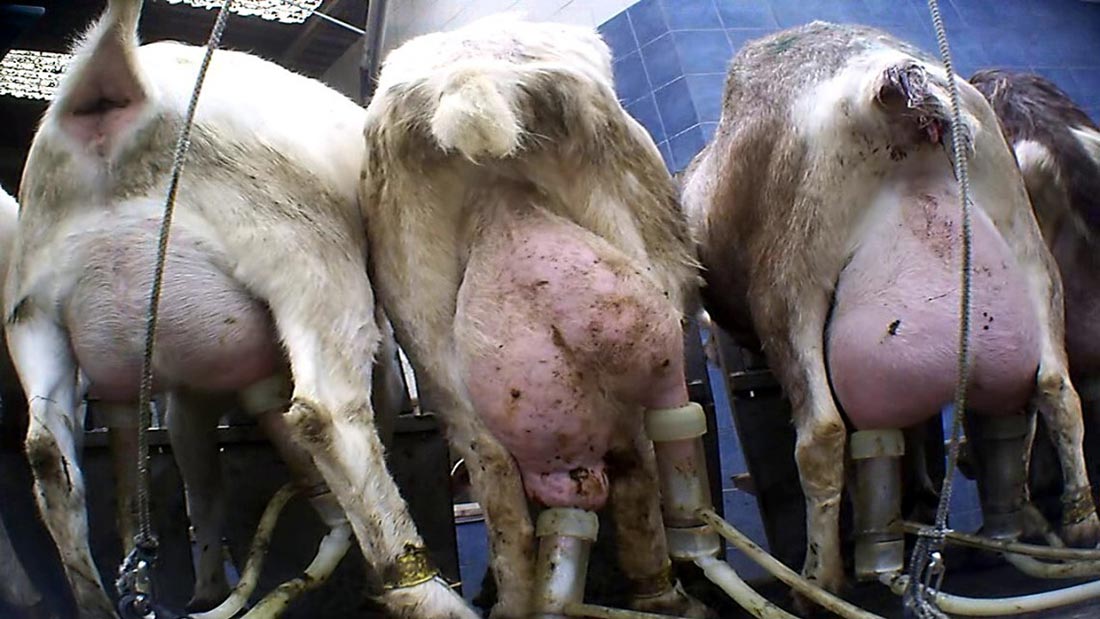
Saanen goats are the breed of choice in UK commercial dairy farms due to their high milk yield and relatively placid nature.15British Goat Society (BGSb). ‘British Saanen.’ British Goat Society. Available at https://www.britishgoatsociety.com/about-us/breeds/british-saanen/ [Accessed 24 April 2020].
The average milk yield a year per goat is approximately 880 litres but with farmers pushing for ever greater yields, more and more goats are being forced to pump out upwards of 1,100 litres and in some cases as high as 1,800.16Gillingham, A. ‘Goats and goat farming – Farming goats for weed control and milk.’ Te Ara – the Encyclopaedia of New Zealand. Available at http://www.TeAra.govt.nz/en/goats-and-goat-farming/page-3 [Accessed 22 April 2020].
Housing and Intensification
Goats are uniquely suited to thriving on tough, mountainous terrain but in the UK, most farmed goats are kept for their entire lives in massive zero grazing (they never go outside) or very limited grazing units.2Rivera, L., 2019. ‘We Need To Be Eating Kid Meat, But What’s The Right Way For It To Be Farmed?’ The Independent, 4 October. Available at https://www.independent.co.uk/life-style/food-and-drink/eating-goat-meat-goatober-kid-farming-industry-dairy-a9128591.html [Accessed 21 April 2020]. It’s done for the ease of herd management and makes life easier for farmers but is certainly not good for the goats, who are naturally active and inquisitive animals.

Goat keeping trends have seen the size of milking herds grow from a handful kept as pets to large zero-grazed commercial farms. It is estimated that the commercial dairy goat population now stands at over 36,000,2Rivera, L., 2019. ‘We Need To Be Eating Kid Meat, But What’s The Right Way For It To Be Farmed?’ The Independent, 4 October. Available at https://www.independent.co.uk/life-style/food-and-drink/eating-goat-meat-goatober-kid-farming-industry-dairy-a9128591.html [Accessed 21 April 2020].with demand predicted to rise annually as more people buy into the ‘healthy alternative’ myth, perpetuated by the industry.1Knowlson, L., 2017. ‘Growing Share in Goat Milk’s UK Market.’ York Press, 20 September. Available at https://www.yorkpress.co.uk/business/news/15527919.growing-share-in-goat-milks-uk-market/ [Accessed 21 April 2020].
While the market for goats remains fairly small, especially in comparison to the millions of cows used in the dairy industry, Viva! has exposed the misleading claims and inherent cruelty behind the goats’ milk industry17Poulter, S., 2012. ‘The ‘cruel’ goat farm where activists claim animals have the tips of their horns burned off with a metal tool to save money as demand for milk and cheese grows.’ Daily Mail, 15 June. Available at https://www.dailymail.co.uk/news/article-2160065/The-cruel-goat-farms-Activists-claim-animals-mistreated-demand-milk-cheese-grows.html [Accessed 24 April 2020]. – it is not a kinder alternative to cow dairy farming.
Zero Grazing
The majority of goat products come from indoor systems. Farmers argue that the breeds of goats they consider best for milking haven’t evolved to a British climate and therefore must be kept indoors. For example, goat’s feet have evolved for rocky, hard terrains rather than soft, wet ground found in the UK which, they claim, risks infections.2Rivera, L., 2019. ‘We Need To Be Eating Kid Meat, But What’s The Right Way For It To Be Farmed?’ The Independent, 4 October. Available at https://www.independent.co.uk/life-style/food-and-drink/eating-goat-meat-goatober-kid-farming-industry-dairy-a9128591.html [Accessed 21 April 2020].
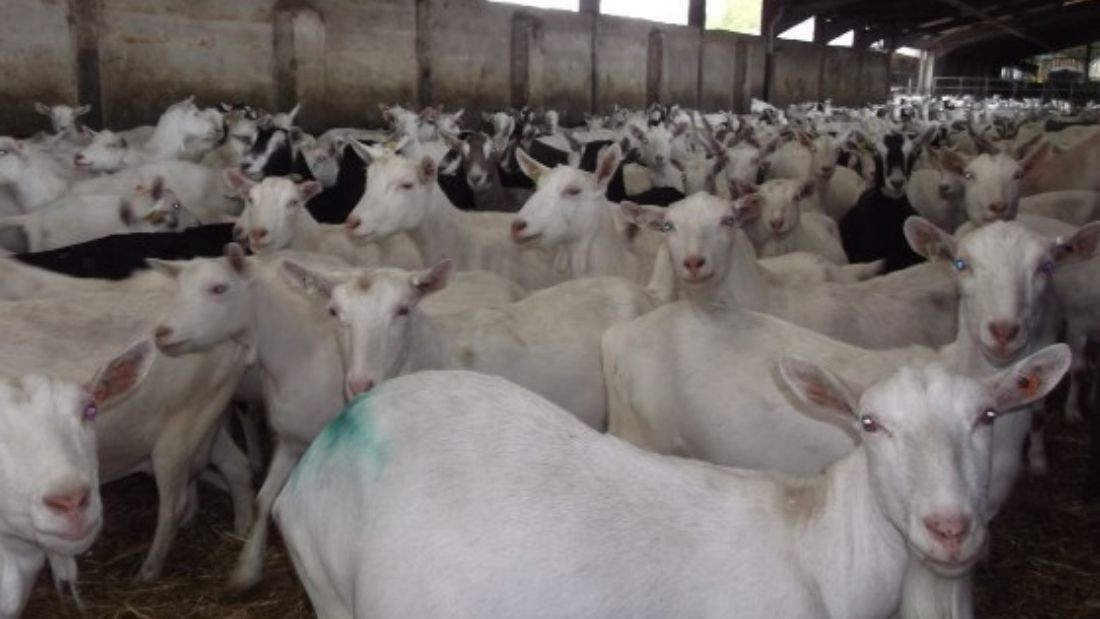
The fact that goats have not evolved for British, muddy environments is touted as an excuse for intensive, zero grazing environments which have no interest for these curious, playful animals. Zero grazing is an abomination, depriving these highly intelligent creatures of all that is natural to them.
Disease and Illness
Despite being generally hardy animals, when goats are ill they rapidly ‘lose the will to live’.18Department for Environment, Food and Rural Affairs, 2011. ‘Goats (England): Code of Recommendations for the Welfare of Livestock’. Defra. Available at http://adlib.everysite.co.uk/adlib/defra/content.aspx?id=000IL3890W.16NTBXJ0EP41AL [Accessed 22 April 2020]. They are vulnerable to multiple notifiable diseases (the Government’s Defra ministry has to be informed), including anthrax, bluetongue, goat pox and foot and mouth disease (FMD).19Department for Environment, Food and Rural Affairs, 2012. ‘Sheep and Goats: Health Regulations.’ Defra, 24 August. Available at https://www.gov.uk/guidance/monitoring-prevention-and-control-of-disease-in-sheep-and-goats#critical-illnesses-of-sheep-and-goats [Accessed 22 April 2020].
FMD can cause sudden, severe lameness, increased abortions and lamb mortality rates and produce sores and blisters covering the feet, mouth and tongue. There is no treatment other than to kill every goat suspected of being infected.19Department for Environment, Food and Rural Affairs, 2012. ‘Sheep and Goats: Health Regulations.’ Defra, 24 August. Available at https://www.gov.uk/guidance/monitoring-prevention-and-control-of-disease-in-sheep-and-goats#critical-illnesses-of-sheep-and-goats [Accessed 22 April 2020].
Scrapie is a fatal brain disease (related to mad cow disease) and is a ‘significant cause of death in sheep and goats’.19Department for Environment, Food and Rural Affairs, 2012. ‘Sheep and Goats: Health Regulations.’ Defra, 24 August. Available at https://www.gov.uk/guidance/monitoring-prevention-and-control-of-disease-in-sheep-and-goats#critical-illnesses-of-sheep-and-goats [Accessed 22 April 2020]. It is impossible to confirm whether a goat has scrapie until he or she has been killed – and so goats suspected of scrapie receive the same ‘treatment’ – slaughter – as goats affected by FMD.19Department for Environment, Food and Rural Affairs, 2012. ‘Sheep and Goats: Health Regulations.’ Defra, 24 August. Available at https://www.gov.uk/guidance/monitoring-prevention-and-control-of-disease-in-sheep-and-goats#critical-illnesses-of-sheep-and-goats [Accessed 22 April 2020].
Lead poisoning poses a severe risk to goats and if farmers allow an accumulation of lead beyond legal limits it can stunt animal growth and kill them.19Department for Environment, Food and Rural Affairs, 2012. ‘Sheep and Goats: Health Regulations.’ Defra, 24 August. Available at https://www.gov.uk/guidance/monitoring-prevention-and-control-of-disease-in-sheep-and-goats#critical-illnesses-of-sheep-and-goats [Accessed 22 April 2020]. Lead can be present in the soil or can come from discarded farming equipment such as batteries.
For intensively-farmed goats, the parasitic disease Coccidiosis is common due to the concentration of faeces in confined spaces.20AgriSmart, 2018. ‘Coccidiosis.’ AgriSmart, April 30. Available at https://www.agrismart.co.uk/coccidiosis/ [Accessed 22 April 2020]. It especially affects kids during the stressful separation from their mothers and can lead to diarrhoea with streaks of blood, followed by severe dehydration and even death.
In general, goats are susceptible to many of the same diseases as sheep, such as clostridial diseases, foot-rot, worms, live fluke and external parasites.21National Animal Disease Information Service. ‘Disease A-Z for Sheep.’ NADIS. Available at https://nadis.org.uk/disease-a-z/sheep/ [Accessed 24 April 2020]. They can also transmit zoonotic diseases to people, such as Q fever and rabies, thus posing a threat to human health stemming directly from the way we use and farm them.22Cornell University. ‘Zoonotic Diseases from Sheep/Goats.’ Cornell University. Available at https://www.vet.cornell.edu/animal-health-diagnostic-center/programs/nyschap/modules-documents/zoonotic-diseases-sheepgoats [Accessed 22 April 2020].
Culling
In the wild, goats would generally live between 15 and 18 years but for those exploited for commercial interests, culling is normally carried out around six years of age.23James, D., 2010. ‘Goat Meat Market Remains Untapped.’ Farmers Weekly, 13 August. Available at https://www.fwi.co.uk/livestock/goat-meat-market-remains-untapped [Accessed 24 April 2020]. Generally, this is when their milk yield drops and they’re no longer considered a profitable commodity. They’re sent to market and sold for meat.

As soon as a goat’s milk yield starts to decline, she is sold for slaughter.
Like most animals at slaughter, goats are supposedly pre-stunned before being killed. The most common method is electrical stunning, where a slaughterer places electrodes on either side of the animal’s head with a device like a large pair of tongs. Its effectiveness depends on where the electrodes are placed on the head, the current and how long they’re applied – and it can fail on all counts.
The other method used is a penetrative captive bolt that is shot into the skull of a goat to make it instantly unconscious.1Department for Environment, Food And Rural Affairs, 2015. ‘Red Meat Slaughterhouses: Restraining, Stunning, Killing Animals.’ Defra, 15 October. Available at https://www.gov.uk/guidance/red-meat-slaughterhouses-restraining-stunning-killing-animals#animal-stunning-and-killing [Accessed 9 April 2020]. The animal is then shackled by a hind leg and hoisted up onto an overhead rail where the slaughter worker ‘sticks’ it, meaning the goat’s neck is sliced open and she bleeds to death. It sounds like a straightforward process but human error and equipment failure ‘severely compromise animal welfare’ with even a low percentage rate of error leading to thousands of goats suffering agony when they are killed.2Humane Slaughter Association. ‘Captive Bolt-Stunning of Livestock.’ Available at https://www.hsa.org.uk/introduction/introduction [Accessed 7 May 2020].
Although it is argued that the death is painless if the goat is successfully stunned, the moments leading up to the stunning and slaughter are often terrifying for the animal. They can hear the noises and smell the fear of other goats in the slaughterhouse, and they do all they can to try and escape. It is a brutal, traumatic experience which cuts a goat’s natural life expectancy by several years.
The stunning process does not guarantee that the goat will lose consciousness before being killed. Their skulls are hard to penetrate, and human error means that the stun person will not always fire the bolt into the head correctly. Goats may also regain consciousness while they are hung up and have their throats slit; one can only imagine the pain of bleeding to death, dragged upwards by one leg.
Approximately 20 million sheep, goats, cattle and poultry were slaughtered in England without being pre-stunned in 2018 to meet the religious demands of certain faiths.3Department for Environment, Food And Rural Affairs, 2019. ‘Results of the 2018 FSA Survey into Slaughter Methods in England and Wales.’ February. Available at https://assets.publishing.service.gov.uk/government/uploads/system/uploads/attachment_data/file/778588/slaughter-method-survey-2018.pdf [Accessed 9 April 2020]. They are bled to death by having their throats slit while fully conscious. While not all animals who are slaughtered for religious purposes are killed without pre-stunning, it is likely that many British consumers unknowingly eat animal products which have come from non-stunned animals because of poor labelling on meat products.4Dalton, J., 2019. ‘Shoppers Unknowingly Buying No-stun Religious Meat in Supermarkets’. The Independent, 19 February. Available at https://www.independent.co.uk/news/uk/home-news/meat-animals-no-stun-halal-meat-supermarkets-religion-kosher-food-ban-standards-agency-a8786541.html [Accessed 25 March 2020].

